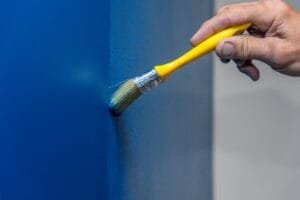Introduction to Durable Wall Paint Finishes
Wall paint finishes refer to the final texture and sheen of a coated surface, impacting the aesthetic and functional elements of both interior and exterior spaces. These finishes vary significantly, each offering its unique qualities that influence the ambiance, maintenance requirements, and durability of walls. Understanding wall paint finishes is essential for homeowners, interior designers, and renovators, as they play a crucial role in achieving the desired look and longevity of painted surfaces.
The sheen of a paint finish can range from flat to high-gloss, with variations in between such as matte, eggshell, satin, and semi-gloss finishes. Each type serves different visual and practical purposes. For instance, a flat finish provides a non-reflective surface ideal for ceilings or areas with minimal wear, while a high-gloss finish can be perfect for spaces that require durability and easy cleaning, such as kitchens and bathrooms. Such characteristics are vital in enhancing the appearance of a space; the right wall paint finish complements the overall design and decor, making rooms feel larger, cozier, or more sophisticated.
Furthermore, the selection of wall paint finishes can significantly affect the longevity and maintenance needs of walls. Durable finishes tend to be more resistant to stains, scratches, and fading, thus ensuring that painted surfaces remain visually appealing over time. Suitable wall paint finishes are also influenced by environmental factors, such as humidity and natural lighting. For example, some finishes are designed specifically for outdoor applications, providing protection against moisture and harsh elements, while others are tailored for indoor use, considering foot traffic and wear patterns. By incorporating durable products like those from Mithila home paints, homeowners can achieve beautiful, lasting results in their decorating endeavors.

Types of Wall Paint Finishes
When it comes to selecting the appropriate wall paint finish, understanding the different types available is essential. Each finish has unique characteristics and applications, influencing both the aesthetic and functional aspects of a space.
The first type is flat paint, which has a non-reflective surface. This finish is ideal for covering imperfections on walls and ceilings, making it a popular choice for living rooms and bedrooms. However, flat paint is less durable than other finishes, which makes it less suitable for high-traffic areas.
Next is eggshell finish, which offers a slight sheen reminiscent of an eggshell. It is more durable than flat paint, making it easier to clean, while still effectively concealing wall imperfections. Eggshell paint is commonly used in dining rooms and hallways, as it strikes a lovely balance between sophistication and practicality.
Satin finishes offer a soft luster, providing a smooth and subtle glimmer. This type is known for its ability to withstand cleaning, making it an excellent choice for kitchens and bathrooms where moisture and frequent cleaning are common. The satin surface also reflects light, enhancing the overall ambiance of the room.
For those seeking higher durability, semi-gloss paint is recommended. This finish is particularly resistant to moisture and stains, which makes it ideal for areas such as kitchens, utility rooms, and on trim work. Its glossy surface can reflect light, adding a contemporary feel to any room.
Finally, high-gloss finishes deliver maximum shine, making them highly suitable for surfaces that demand a more vibrant look, such as cabinets, moldings, and furniture. While these finishes are the most durable and easy to clean, they can highlight wall imperfections, necessitating careful surface preparation before application.
Choosing the right mithila home paints finish ultimately depends on the intended use of the space and the desired aesthetic effect. Each finish serves a unique purpose, ensuring that the final outcome aligns with personal preferences and functional requirements




Factors Affecting Durability
The durability of wall paint finishes is influenced by several interconnected factors that can significantly impact their performance and longevity. One of the primary considerations is the quality of the paint itself. High-quality paints, such as mithila home paints, are formulated with superior ingredients and technology, resulting in finishes that resist fading, chipping, and peeling over time. Investing in quality materials is essential, as they provide a more robust defense against wear and environmental stressors.
Another crucial factor is the environment in which the paint is applied. Conditions such as humidity and temperature can substantially affect the drying and curing process of the paint. For instance, high humidity levels can lead to longer drying times, which might prevent the paint from bonding effectively to the surface. Conversely, very low temperatures can also hinder the curing of paints, compromising their durability. Therefore, it is advisable to consider the weather conditions prior to application and choose mithila home paints specifically designed to perform under varying environmental conditions.
Additionally, proper surface preparation before painting plays a vital role in ensuring durability. The underlying surface should be clean, dry, and free of any contaminants that could interfere with paint adhesion. This preparation might include sanding, priming, and repairing any imperfections, all of which contribute to a stable base for the paint. Lastly, application techniques cannot be overlooked. Employing the right tools and methods, such as using brushes or rollers suited for specific paint types, is essential for achieving an even finish and optimal durability. Misapplication can lead to issues such as uneven coverage or bubbling, which ultimately detracts from the paint’s lifespan.
Benefits of Durable Wall Paint Finishes
Choosing durable wall paint finishes provides numerous advantages for homeowners and commercial property owners alike. One of the primary benefits is the reduced need for maintenance. Durable finishes, such as mithila home paints, are designed to withstand the effects of wear and tear, making them suitable for high-traffic areas. Unlike traditional paints that may require frequent touch-ups or repaints, these durable options can maintain their appearance over time, saving both labor and material costs.
Enhanced aesthetic appeal is another significant benefit associated with durable wall paint finishes. With a wide range of colors and textures available, mithila home paints can elevate the visual appeal of any room. Their long-lasting qualities ensure that the vibrant colors remain intact, providing a fresh and polished look for extended periods. This ability to maintain their aesthetics helps in creating inviting environments, whether in residential homes or commercial spaces.
Cost-effectiveness is a compelling factor when considering wall paint finishes. Although the initial investment in high-quality durable paint may be higher than that of standard options, the long-term savings can be substantial. Durable finishes reduce the frequency of repainting, lower maintenance costs, and protect the underlying wall structure from moisture, mildew, and damage. Therefore, over time, the initial expense often pays for itself through minimized upkeep and replacement costs.
Additionally, high-performance wall paints offer better resistance to stains and scuff marks, making them an excellent choice for common areas such as hallways, kitchens, and living rooms. Their protective attributes ensure that walls remain in excellent condition, enhancing the overall durability and lifespan of the paint. For those seeking a reliable and attractive option for their interiors, durable wall paint finishes, particularly mithila home paints, are certainly worth considering.

Preparing Walls for Durable Paint Finishes
Before applying mithila home paints or any durable paint finishes, adequate preparation of the wall surfaces is critical to ensure optimal adhesion and longevity. The first step is thorough cleaning. Walls often accumulate dust, grease, and other contaminants that can interfere with paint adhesion. Utilizing a quality household cleaner, you should scrub the walls to remove any residue. A mild solution of warm water and soap is typically sufficient for removing most dirt. Allow the surface to dry completely before moving to the next step.
Next, addressing any imperfections in the wall surface is paramount. This includes filling in holes, cracks, and dents with a suitable patching compound. After applying the filler, it is advisable to let it cure as per the manufacturer’s instructions and then sand it smooth to create an even surface. This step is vital as uneven surfaces can hinder the smooth application of mithila home paints and lead to a less aesthetically pleasing finish.
Once the walls are patched and smoothed, we move on to sanding the entire surface lightly. Sanding, done with fine-grit sandpaper, will not only help to smooth out rough areas but also create a texture that enhances the adhesion of the paint. Post-sanding, remove all dust with a damp cloth or a vacuum cleaner equipped with a brush attachment to ensure that no particles impede the paint’s performance.
The final step in preparations entails applying a primer. Priming is especially important when dealing with porous surfaces or previously unpainted areas as it creates a uniform base that improves the adherence of the finish coat. It can also enhance the coverage of the paint, ensuring fewer coats are required later on. Following these preparatory steps diligently will significantly extend the lifespan and durability of your wall paint finishes.

Application Techniques for Lasting Results
The application of wall paint is critical in achieving a durable finish that stands the test of time. Among the various methods available, brushing, rolling, and spraying are the most common techniques employed. Each method has its own set of advantages and disadvantages, which can affect the overall outcome.
Brushing is a traditional method that allows for precision and control, making it ideal for detailed work and smaller areas. With brushes, one can easily navigate corners, edges, and intricate designs. However, this technique may require more time and effort, leading to visible brush strokes if not applied correctly. On the other hand, rolling is efficient for covering larger surfaces quickly and provides a smooth, even finish. Using a roller helps minimize the risk of streaks and is generally favored for its labor-saving benefits. Yet, careful attention is needed around the edges to prevent unpainted patches.
Spraying, another popular technique, offers a fine mist of paint that can cover surfaces uniformly and swiftly. This method is particularly useful for very large areas or textured surfaces that roller or brush applications might struggle to cover adequately. However, it requires more equipment and often involves a learning curve to perfect the technique. Additionally, overspray can create messes, so proper masking is essential to avoid unintended paint application.
To ensure a lasting finish, it is vital to employ best practices for each application technique. Surface preparation must not be neglected; this includes cleaning the walls, repairing any damages, and priming when necessary, especially when using mithila home paints or similar products. Patience during the drying process and applying multiple thin coats can also enhance durability, transforming your wall paint into a resilient layer that will endure wear and tear for years to come.

Maintenance Tips for Durable Paint Finishes
Maintaining the aesthetic appeal and durability of your wall paint is integral to preserving the overall integrity of your home. For those who choose mithila home paints or any other quality finishes, adopting a regular maintenance routine can significantly enhance the lifespan of the paint on your walls. Here are some practical tips to keep your paint looking fresh and vibrant.
First and foremost, consider cleaning your painted surfaces regularly. Dust and dirt can accumulate over time, leading to dullness in appearance. To clean, use a soft, damp cloth or sponge with mild soap, ensuring the solution is not overly abrasive. For more stubborn stains, a gentle scrub with a non-abrasive sponge can be effective. It is advisable to test any cleaning solution in a small, inconspicuous area before full application to avoid any potential damage to the paint finish.
Furthermore, touching up minor imperfections is essential for maintaining the pristine look of mithila home paints. If you notice scuffs or scratches, consider using a matching paint touch-up kit. Always store extra paint from the original application to ensure consistency in color. For larger areas requiring retouching, blend the new paint into the existing finish for a seamless repair.
To prevent damage to your wall paint, such as peeling or fading, consider establishing a preventative maintenance plan. This may include avoiding hanging heavy objects directly on painted walls or using wall protectors, especially in high-traffic areas. Additionally, consider the impact of sunlight; using sheer curtains can reduce harsh UV exposure, which can fade and deteriorate many paint finishes over time.
In conclusion, implementing these maintenance tips will greatly aid in preserving the durability and appearance of your wall paint. By regularly cleaning, properly touching up, and taking preventative measures, you will ensure that your mithila home paints remain vibrant and long-lasting, enhancing the beauty of your home for years to come.
Common Mistakes to Avoid
Choosing the right wall paint finish can be a daunting task, and many individuals fall into common pitfalls that can significantly impact the effectiveness and longevity of their choices. One prevalent misconception is the belief that all paints are interchangeable, leading consumers to erroneously select a finish based solely on color, without considering the specific traits of different paint types. For instance, opting for a flat finish in a high-traffic area, such as a hallway, can result in premature wear and complex maintenance challenges. Instead, selecting a durable finish, such as satin or semi-gloss, which is often better suited for high-usage spaces, is crucial for ensuring lasting results.
Another frequent mistake arises during the preparation phase, an essential step that many people overlook or rush through. Failing to properly clean, sand, and prime surfaces can lead to poor adhesion, resulting in an uneven finish and paint peeling over time. For instance, if you are applying mithila home paints, ensuring the walls are clean and primed not only enhances the aesthetic appeal but also promotes durability. Adequate surface preparation provides a solid foundation for the paint, reducing the risk of errors and ensuring a longer-lasting finish.
Furthermore, many homeowners underestimate the importance of ongoing maintenance. A common oversight is neglecting minor repairs or failing to regularly clean walls once painted. These factors can significantly detract from the paint’s appearance and lifespan. Simple actions, such as wiping down surfaces with a gentle cleanser, can prevent dirt buildup and maintain the vibrancy of your mithila home paints. By addressing these mistakes—understanding paint types, committing to proper preparation, and implementing regular maintenance—individuals can empower themselves to make informed decisions, leading to successful and enduring wall finishes.
Conclusion and Final Thoughts
In the realm of interior design, the selection of durable wall paint finishes is a crucial aspect that can significantly influence the longevity and aesthetic appeal of living spaces. As discussed throughout this guide, the right choice of mithila home paints or their equivalents can provide a robust solution that resists wear and tear while maintaining their vibrant appearance over time. Durability is not merely a desirable trait; it is an essential factor that contributes to the overall value of one’s home.
Among the myriad benefits of selecting high-quality wall finishes, one can highlight their resistance to stains, ease of cleaning, and ability to endure the challenges posed by varying environmental conditions. These characteristics not only enhance the visual integrity of the walls but also minimize the frequency and cost of repainting, leading to substantial savings in the long run. For homeowners, incorporating mithila home paints or similar products into their renovation or decoration strategies can ensure both practicality and style.
It is paramount for individuals to assess their specific needs and preferences when choosing paint finishes. Considerations such as the intended usage of a space, exposure to moisture, and desired aesthetic outcomes can guide the decision-making process. Additionally, understanding the application methods and maintenance requirements associated with different finishes can further empower homeowners to make informed choices. Ultimately, investing in durability should be viewed as a commitment to maintaining the beauty and functionality of home environments.
As this guide has illustrated, carefully selecting durable wall paint finishes can lead to enhanced performance and satisfaction. Prioritizing these features in mithila home paints allows for a harmonious blend of resilience and elegance, ensuring that your walls remain a point of pride within your living spaces.

